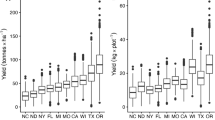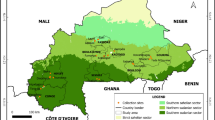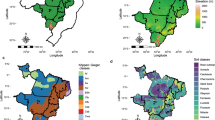Abstract
Eucalyptus dunnii Maiden (Dunn’s white gum) is a fast-growing tall tree with a restricted natural distribution in south-east Australia and favorable wood properties for pulp production. In this study, selected and native forest family seedlots of E. dunnii were evaluated in 17 open-pollinated progeny trials located in Australia, Uruguay, China, Argentina, and Spain for diameter at breast height and total height between the ages of 1 and 7 years. The generality of the factor analytic approach was extended to accommodate unbalance in treatment effects and traits, by modelling each dimension of the genotype covariance matrix as a unique combination of location, age, and trait. Genetic correlations between the two growth traits, between trials and between ages were generally high with only five trials exhibiting average trial-trial correlations below 0.7, indicating genotype by environment interactions were low. Estimated individual seedlot repeatability varied from 0.04 to 0.18 for both traits. The results of this study show that selection and deployment across multiple trials within Australia, Uruguay, China, and Argentina is possible from a single breeding program of E. dunnii, however some environments will require further investigation to determine the drivers of the observed GxE.





Similar content being viewed by others
Availability of data and material
The datasets generated during and/or analyzed during the current study are not publicly available due to commercial confidence and intellectual property but are available from the corresponding author on reasonable request.
References
Akaike H (1974) A new look at the statistical model identification. IEEE Trans Autom Control 19:716–723
Apiolaza LA (2009) Very early selection for solid wood quality: screening for early winners. Ann For Sci 66:1–10
Arnold RJ, Clarke B, Luo J (2004) Trials of Cold Tolerant Eucalypt Species in Cooler Regions of South Central China. ACIAR Technical Report No. 57, Australian Centre for International Agricultural Research, Canberra, 106 pp
Atkin FC, Dieters MJ, Stringer JK (2009) Impact of depth of pedigree and inclusion of historical data on the estimation of additive variance and breeding values in a sugarcane breeding program. Theor Appl Genet 119:555–565. https://doi.org/10.1007/s00122-009-1065-7
Backman M, Garcia De León J (2003) Correlations of pulp and paper properties at an early age and full rotation age of five eucalyptus species. In: 28th EUCEPA Conference: sustainable development for the pulp and paper industry: proceedings, oral and poster presentations. pp 2–4
Basford K, Cooper M (1998) Genotype×environment interactions and some considerations of their implications for wheat breeding in Australia. Aust J Agric Res 49:153–174
Benson J, Hager T (1993) The distribution, abundance and habitat of Eucalyptus dunnii (Myrtaceae) (Dunn’s white gum) in New South Wales. Cunninghamia 3:123–145
Binkley D, Campoe OC, Alvares CA, Carneiro RL, Stape JL (2020) Variation in whole-rotation yield among Eucalyptus genotypes in response to water and heat stresses: The TECHS project. For Ecol Manag 462:117953
Booth TH, Jovanovic T, New M (2002) A new world climatic mapping program to assist species selection. For Ecol Manag 163:111–117. https://doi.org/10.1016/S0378-1127(01)00531-X
Borralho N (1992) Genetic control of growth of Eucalyptus globulus in Portugal. 1. Genetic and phenotypic parameters. Silvae Genet 41:39–45
Borralho N (1994) Heterogeneous selfing rates and dominance effects in estimating heritabilities from open-pollinated progeny. Can J For Res 24:1079–1082
Burdon R (1977) Genetic correlation as a concept for studying genotype-environment interaction in forest tree breeding. Silvae Genet 26:168–175
Bush D, Kain D, Kanowski P, Matheson C (2014) Genetic parameter estimates informed by a marker-based pedigree: a case study with Eucalyptus cladocalyx in southern Australia. Tree Genet Genom 11:798. https://doi.org/10.1007/s11295-014-0798-x
Byrne M (2008) Phylogeny, diversity and evolution of eucalypts. In ‘Plant genome: biodiversity and evolution. Vol. 1. Part E. Phanerogams–Angiosperm’.(Eds AK Sharma, A Sharma) pp. 303–346. Science Publishers: Enfield, NH, USA
Callister AN, England N, Collins S (2011) Genetic analysis of Eucalyptus globulus diameter, straightness, branch size, and forking in Western Australia. Can J For Res 41:1333–1343. https://doi.org/10.1139/X11-036
Chaix G, Gerber S, Razafimaharo V, Vigneron P, Verhaegen D, Hamon S (2003) Gene flow estimation with microsatellites in a Malagasy seed orchard of Eucalyptus grandis. Theor Appl Genet 107:705–712
Chaix G, Vigneron P, Razafimaharo V, Hamon S (2007) Are phenological observations sufficient to estimate the quality of seed crops from a Eucalyptus grandis open-pollinated seed orchard? Consequences for seed collections. New For 33:41–52
Cooper M, Brennan P, Sheppard J (1996) A strategy for yield improvement of wheat which accommodates large genotype by environment interactions. In: Cooper M, Hammer GL (eds) Plant adaptation and crop improvement. CAB International, Wallingford, pp 487–512
Costa e Silva J, Hardner C, Tilyard P, Potts B (2011) The effects of age and environment on the expression of inbreeding depression in Eucalyptus globulus. Heredity 107:50–60
Costa e Silva J, Potts BM, Dutkowski GW (2006) Genotype by environment interaction for growth of Eucalyptus globulus in Australia. Tree Genet Genom 2:61–75
de Araujo MJ, de Paula RC, Campoe OC, Carneiro RL (2019) Adaptability and stability of eucalypt clones at different ages across environmental gradients in Brazil. For Ecol Manag 454:117631
de Leon N, Jannink J-L, Edwards JW, Kaeppler SM (2016) Introduction to a special issue on genotype by environment interaction. Crop Sci 56:2081–2089
de los Santos E (2016) Effect of tree age of Eucalyptus dunnii from Uruguay on wood basic density, pulping yield, wooc chemical composition and fibre morphology. Masters Thesis, Universidad de la República, Montevideo, Uruguay
Dieters M, White T, Hodge G (1995) Genetic parameter estimates for volume from fuil-sib tests of slash pine (Pinus elliottii). Can J For Res 25:1397–1408
Dobner J, Batista K, Sartório I, Arce J, Quadros D (2017) Crescimento e desempenho econômico de Eucalyptus dunnii em diferentes sítios no planalto sul do Brasil. Floresta 47:397–406
Eldridge K, Davidson J, Harwood C, van Wyk G (1993) Eucalypt domestication and breeding. Clarendon Press, Oxford
Eldridge K, Griffin AR (1983) Selfing effects in Eucalyptus regnans. Silvae Genet 32:216–221
Falconer D, Mackay T (1996) An Introduction to quantitative genetics, 4th edn. Prentice Hall, London
Falconer DS (1952) The Problem of Environment and Selection. Am Nat 86:293–298. https://doi.org/10.1086/281736
Gallo R et al (2018) Growth and wood quality traits in the genetic selection of potential Eucalyptus dunnii Maiden clones for pulp production. Ind Crops Prod 123:434–441. https://doi.org/10.1016/j.indcrop.2018.07.016
Grant JC, Nichols JD, Smith RGB, Brennan P, Vanclay JK (2010) Site index prediction of Eucalyptus dunnii Maiden plantations with soil and site parameters in sub-tropical eastern Australia. Aust For 73:234–245
Greaves BL, Borralho NM, Raymond CA, Evans R, Whiteman P (1997) Age-age correlations in, and relationships between basic density and growth in Eucalyptus nitens. Silvae Genet 46:264–269
Greaves BL, Borralho NMG, Raymond CA (2003) Early selection in eucalypt breeding in Australia: optimum selection age to minimise the total cost of kraft pulp production. New For 25:201–210. https://doi.org/10.1023/a:1022996930025
Grieser J (2006) New LocClim 1.10: local climate estimator. FAO, Rome
Griffin A, Cotterill P (1988) Genetic variation in growth of outcrossed, selfed and open-pollinated progenies of Eucalyptus regnans and some implications for breeding strategy. Silvae Genet 37:124–131
Grosser C, Potts B, Vaillancourt RE (2010) Microsatellite based paternity analysis in a clonal Eucalyptus nitens seed orchard. Silvae Genet 59:57–62
Gu Z, Eils R, Schlesner M (2016) Complex heatmaps reveal patterns and correlations in multidimensional genomic data. Bioinformatics 32:2847–2849
Hahsler M, Hornik K, Buchta C (2008) Getting things in order: an introduction to the R package seriation. J Stat Softw 25:1–34
Hardner C (2017) Exploring opportunities for reducing complexity of genotype-by-environment interaction models. Euphytica 213:248
Hardner C, Dieters M, DeLacy I, Neal J, Fletcher S, Dale G, Basford K (2011) Identifying deployment zones for Eucalyptus camaldulensis x E. globulus and x E. grandis hybrids using factor analytic modelling of genotype by environment interaction. Aust For 74:30–35
Hardner C, Potts B (1995) Inbreeding depression and changes in variation after selfing in Eucalyptus globulus ssp. globulus. Silvae Genet 44:46–54
Hardner C, Tibbits W (1998) Inbreeding depression for growth, wood and fecundity traits in Eucalyptus nitens. For Genet 5:11–20
Hardner CM, Dieters M, Dale G, DeLacy I, Basford KE (2010) Patterns of genotype-by-environment interaction in diameter at breast height at age 3 for eucalypt hybrid clones grown for reafforestation of lands affected by salinity. Tree Genet Genom 6:833–851
Hardner CM, Healey AL, Downes G, Herberling M, Gore PL (2016) Improving prediction accuracy and selection of open-pollinated seed-lots in Eucalyptus dunnii Maiden using a multivariate mixed model approach. Ann For Sci 73:1035–1046
Harris F (2007) The effect of competition on stand, tree, and wood growth and structure in subtropical Eucalyptus grandis plantations. PhD thesis, Southern Cross University, Lismore, NSW
Hayatgheibi H, Fries A, Kroon J, Wu HX (2018) Estimation of genetic parameters, provenance performances, and genotype by environment interactions for growth and stiffness in lodgepole pine (Pinus contorta). Scand J For Res:1–11
Henry RJ, Kole C (2014) Genetics, genomics and breeding of eucalypts. CRC Press Inc, London
Henson M et al. (2004) Genetic parameters of wood properties in a 9 year old E. dunnii progeny trial in NSW, Australia. In: Eucalyptus in a Changing World, Aveiro, Portugal
Henson M, Vanclay JK (2004) The value of good sites and good genotypes: an analysis of Eucalyptus dunnii plantations in NSW. In: The Economics and Management of High Productivity Plantations, Lugo, Spain. pp 27–30
Hill W (1984) On selection among groups with heterogeneous variance. Anim Sci 39:473–477
Hodge G, Volker P, Potts B, Owen J (1996) A comparison of genetic information from open-pollinated and control-pollinated progeny tests in two eucalypt species. Theor Appl Genet 92:53–63
Hodge GR, Dvorak WS (1999) Genetic parameters and provenenance variation of Pinus tecunumanii in 78 international trials. Forest Gen 6:157–180
Jovanovic T, Arnold R, Booth T (2000) Determining the climatic suitability of Eucalyptus dunnii for plantations in Australia, China and Central and South America. New For 19:215–226
Kenward MG, Roger JH (1997) Small sample inference for fixed effects from restricted maximum likelihood. Biometrics 53:983–997
Kien N, Jansson G, Harwood C, Almqvist C (2009) Clonal variation and genotype by environment interactions in growth and wood density in Eucalyptus camaldulensis at three contrasting sites in Vietnam. Silvae Genet 59:17–28
Li C et al (2017a) Genetic parameters for growth and wood mechanical properties in Eucalyptus cloeziana F. Muell. New For 48:33–49. https://doi.org/10.1007/s11056-016-9554-4
Li Y, Suontama M, Burdon RD, Dungey HS (2017b) Genotype by environment interactions in forest tree breeding: review of methodology and perspectives on research and application. Tree Genet Genom 13:60. https://doi.org/10.1007/s11295-017-1144-x
Lima JL, Souza JCd, Ramalho MAP, Andrade HB, Sousa LCd (2011) Early selection of parents and trees in Eucalyptus full-sib progeny tests. Crop Breed Appl Biot 11:10–16
Lopez GA, Potts BM, Dutkowski GW, Apiolaza LA, Gelid P (2002) Genetic variation and inter-trait correlations in Eucalyptus globulus base population trials in Argentina. For Gen 9:217–231
Marcó MA, White TL (2002) Genetic parameter estimates and genetic gains for Eucalyptus grandis and E. dunnii in Argentina. For Gen 9:205–215
Matheson A, Cotterill P (1990) Utility of genotype× environment interactions. For Ecol Manag 30:159–174
Matheson AC, Raymond CA (1986) A review of provenance x environment interaction: its practical importance and use with particular reference to the tropics. Commonw For Rev 65:283–302
Ministerio de Ganadería AyP (2018) National Forest Mapping Results Report. https://www.gub.uy/ministerio-ganaderia-agricultura-pesca/comunicacion/publicaciones/informe-resultados-cartografia-forestal-nacional-2018. Accessed 28 May 2020
Núñez P et al (2011) Molecular Certification Laboratory of Arauco. BMC Proc 5:181. https://doi.org/10.1186/1753-6561-5-S7-P181
Osorio L, White T, Huber D (2001) Age trends of heritabilities and genotype-by-environment interactions for growth traits and wood density from clonal trials of Eucalyptus grandis Hill ex Maiden. Silvae Genet 50:108–116
Piepho HP, Möhring J, Melchinger AE, Büchse A (2008) BLUP for phenotypic selection in plant breeding and variety testing. Euphytica 161:209–228. https://doi.org/10.1007/s10681-007-9449-8
Potts B, Savva M (1988) Self-incompatibility in Eucalyptus. In: Knox R, Sing M, Troiani L (eds) Pollination 88. Plant Cell Biology Research Centre, University of Melbourne, Melbourne, pp 165-170
Potts B, Volker P, Hodge G, Borralho N, Hardner C, Owen J (1995) Genetic limitations in the exploitation of base populations of Eucalyptus globulus ssp. globulus. In: Potts B, Borralho N, Reid J, Cromer R, Tibbits W, Raymond C (eds) Eucalypt plantations: improving fibre yield and quality. Cooperative Research Centre for Temperate Hardwood Forestry, Hobart, pp 217-221
Raymond CA (2011) Genotype by environment interactions for Pinus radiata in New South Wales, Australia. Tree Genet Genom 7:819–833
Resende MDV, Thompson R (2004) Factor analytic multiplicative mixed models in the analysis of multiple experiments. Rev Mat Estat 22:31–52
Resquin F, Navarro-Cerrillo R, Rachid-Casnati C, Hirigoyen A, Carrasco-Letelier L, Duque-Lazo J (2018) Allometry, growth and survival of three Eucalyptus species (Eucalyptus benthamii Maiden and Cambage, E. dunnii Maiden and E. grandis Hill ex Maiden) in high-density plantations in Uruguay. Forests 9:745. https://doi.org/10.3390/f9120745
Resquin F, Navarro-Cerrillo RM, Carrasco-Letelier L, Casnati CR (2019) Influence of contrasting stocking densities on the dynamics of above-ground biomass and wood density of Eucalyptus benthamii, Eucalyptus dunnii, and Eucalyptus grandis for bioenergy in Uruguay. For Ecol Manag 438:63–74. https://doi.org/10.1016/j.foreco.2019.02.007
Rodríguez P, Perea T, Jiménez B, Francia M, Parra L, Durán Z (2015) Field performance of Eucalyptus stands for bioenergy in Southern Spain. Asp Appl Biol 131:199–209
Shi T, Arnold RJ, Kang W, Duan F, Qian Y, Xie H, Xu J (2016) Genetic variation and gains for two generations of Eucalyptus dunnii in China. Aust For 79:15–24
Silva PHM, Brune A, Alvares CA, Amaral Wd, Moraes MLTd, Grattapaglia D, de Paula RC (2019a) Selecting for stable and productive families of Eucalyptus urophylla across a country-wide range of climates in Brazil. Can J For Res 49:87–95
Silva PHM, Marco M, Alvares CA, Lee D, de Moraes MLT, de Paula RC (2019b) Selection of Eucalyptus grandis families across contrasting environmental conditions. Crop Breed Appl Biotechnol 19:47–54. https://doi.org/10.1590/1984-70332019v19n1a07
Smith A, Cullis B, Thompson R (2001) Analyzing variety by environment data using multiplicative mixed models and adjustments for spatial field trend. Biometrics 57:1138–1147
Smith AB, Borg LM, Gogel BJ, Cullis BR (2019) Estimation of factor analytic mixed models for the analysis of multi-treatment multi-environment trial data. J Agric Biol Environ Stat. https://doi.org/10.1007/s13253-019-00362-6
Smith HJ, Henson M (2007) Achievements in forest tree genetic improvement in Australia and New Zealand 3: Tree improvement of Eucalyptus dunnii Maiden. Aust For 70:17–22. https://doi.org/10.1080/00049158.2007.10676257
Squillace A (1974) Average genetic correlations among offspring from open-pollinated forest trees. Silvae Genet 23:149–155
Stackpole DJ, Vaillancourt RE, de Aguigar M, Potts BM (2010) Age trends in genetic parameters for growth and wood density in Eucalyptus globulus. Tree Genet Genom 6:179–193. https://doi.org/10.1007/s11295-009-0239-4
Tambarussi EV, Pereira FB, da Silva PHM, Lee D, Bush D (2018) Are tree breeders properly predicting genetic gain? A case study involving Corymbia species. Euphytica 214:150. https://doi.org/10.1007/s10681-018-2229-9
Tan B, Grattapaglia D, Wu HX, Ingvarsson PK (2017) Genomic prediction reveals significant non-additive effects for growth in hybrid Eucalyptus. bioRxiv:178160
Torres-Dini D et al (2016) Clonal selection of Eucalyptus grandis x Eucalyptus globulus for productivity, adaptability, and stability, using SNP markers. Silvae Genet 65:30–38
Van Eeuwijk F, Cooper M, DeLacy I, Ceccarelli S, Grando S (2001) Some vocabulary and grammar for the analysis of multi-environment trials, as applied to the analysis of FPB and PPB trials. Euphytica 122:477–490
Van Wyk G (1990) Genetic improvement of timber yield and wood quality in Eucalyptus Grandis (Hill) Maiden: Part I. Genetic parameters of growth characteristics. S Afr For J 153:1–11
Van Wyk W, Gerischer G (1994) Pulping characteristics of Eucalyptus provenance trials grown in the Western Cape: Part 1: Comparison between species. S Afr For J 170:1–5. https://doi.org/10.1080/00382167.1994.9629667
Varghese M, Harwood C, Hegde R, Ravi N (2008) Evaluation of provenances of Eucalyptus camaldulensis and clones of E. camaldulensis and E. tereticornis at contrasting sites in southern India. Silvae Genet 57:170–179
Velilla E, Borralho N, Vargas-Reeve F, Fernández M, Emhart V Patterns of additive and non-additive genotype by environment interaction for growth of Eucalyptus globulus in southern and central Chile. In: Eucalyptus 2018: Managing Eucalyptus plantation under global changes, Montpellier, France, 2018
Volker PW, Potts BM, Borralho NM (2008) Genetic parameters of intra-and inter-specific hybrids of Eucalyptus globulus and E. nitens. Tree Genet Genom 4:445–460
Wang G, Arnold R, Gardiner C, Zhang J, Wu Z (1999) Seed source variation for growth in Eucalyptus dunnii; results from trials in south central China. Aust For 62:120–127
Wei X, Borralho N (1998) Genetic control of growth traits of Eucalyptus urophylla S.T. Blake in south east China. Silvae Genet 47:158–165
White I (2017) Pin function for asreml-R. http://www.homepages.ed.ac.uk/iwhite//asreml/
White TL, Adams WT, Neale DB (2007) Forest genetics. CAB International Wallingford
Wu H, Yeh F, Pharis R (1998) Study of early selection in tree breeding. Silvae Genet 47:146–155
Wu HX, Matheson AC (2005) Genotype by environment interactions in an Australia-wide radiata pine diallel mating experiment: implications for regionalized breeding. For Sci 51:29–40
Wu HX, Powell MB, Yang JL, Ivković M, McRae TA (2007) Efficiency of early selection for rotation-aged wood quality traits in radiata pine. Ann For Sci 64:1–9
Yang H, Su G (2016) Impact of phenotypic information of previous generations and depth of pedigree on estimates of genetic parameters and breeding values. Livest Sci 187:61–67
Yang HY et al (2018) Genotypic variation and genotype-by-environment interactions in growth and wood properties in a cloned Eucalyptus urophylla x E. tereticornis family in southern China. For Sci 64:225–232. https://doi.org/10.1093/forsci/fxx011
Yu Q, Pulkkinen P (2003) Genotype–environment interaction and stability in growth of aspen hybrid clones. For Ecol Manag 173:25–35
Acknowledgements
This study was supported by funding from an Innovation Connections grant. We thank Montes del Plata, UPM, Arauco Argentina, ENCE, Yong’an Forest Company, Hancock Victoria Plantations, and the Chinese Eucalypt Research Company for the provision of data from trials. We thank Barry Vaughan for reviewing the manuscript.
Author information
Authors and Affiliations
Corresponding author
Ethics declarations
Conflict of interest
The authors declare that they have no conflict of interest.
Additional information
Publisher's Note
Springer Nature remains neutral with regard to jurisdictional claims in published maps and institutional affiliations.
Appendix
Appendix
See Table
7.
Rights and permissions
About this article
Cite this article
Bird, M.G., Hardner, C.M., Dieters, M. et al. Global genotype by environment trends in growth traits for Eucalyptus dunnii. New Forests 53, 101–123 (2022). https://doi.org/10.1007/s11056-021-09846-1
Received:
Accepted:
Published:
Issue Date:
DOI: https://doi.org/10.1007/s11056-021-09846-1




